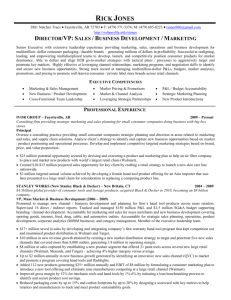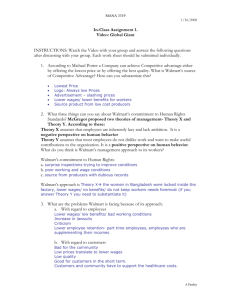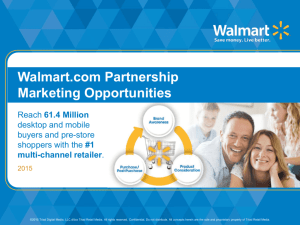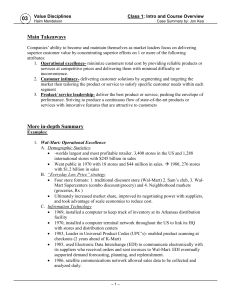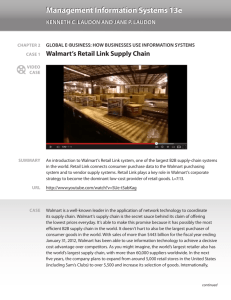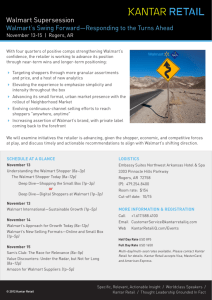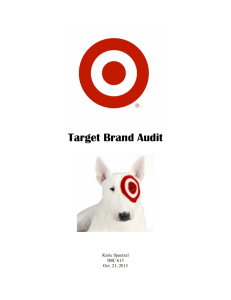Value Disciplines - Derning Solutions
advertisement
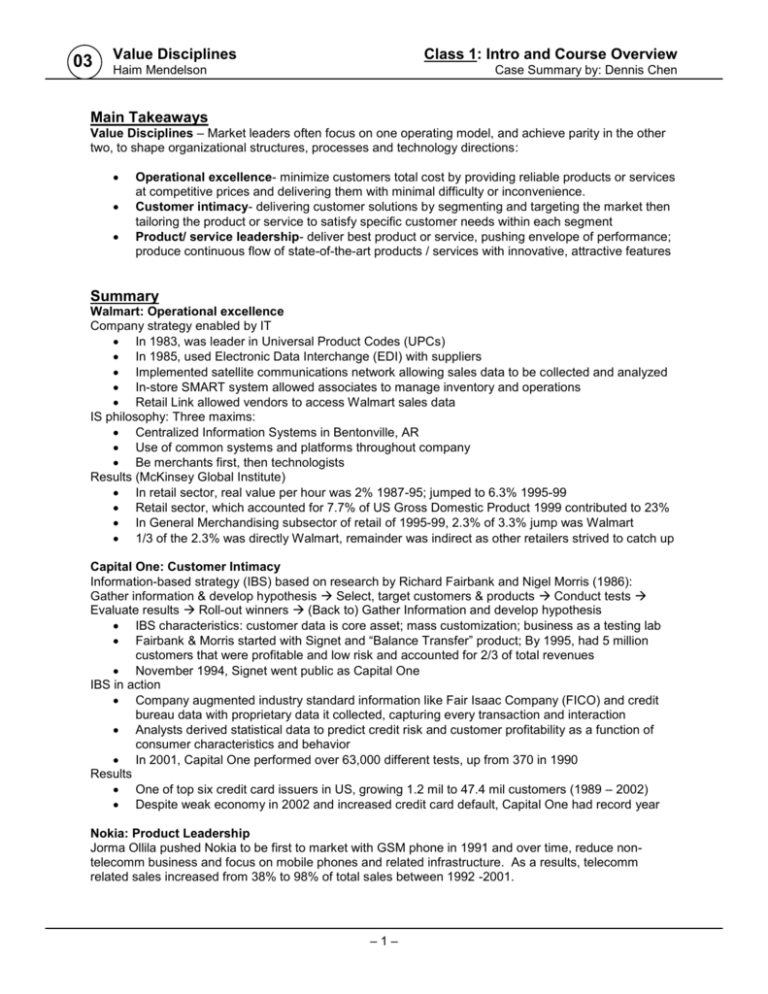
03 Value Disciplines Class 1: Intro and Course Overview Haim Mendelson Case Summary by: Dennis Chen Main Takeaways Value Disciplines – Market leaders often focus on one operating model, and achieve parity in the other two, to shape organizational structures, processes and technology directions: Operational excellence- minimize customers total cost by providing reliable products or services at competitive prices and delivering them with minimal difficulty or inconvenience. Customer intimacy- delivering customer solutions by segmenting and targeting the market then tailoring the product or service to satisfy specific customer needs within each segment Product/ service leadership- deliver best product or service, pushing envelope of performance; produce continuous flow of state-of-the-art products / services with innovative, attractive features Summary Walmart: Operational excellence Company strategy enabled by IT In 1983, was leader in Universal Product Codes (UPCs) In 1985, used Electronic Data Interchange (EDI) with suppliers Implemented satellite communications network allowing sales data to be collected and analyzed In-store SMART system allowed associates to manage inventory and operations Retail Link allowed vendors to access Walmart sales data IS philosophy: Three maxims: Centralized Information Systems in Bentonville, AR Use of common systems and platforms throughout company Be merchants first, then technologists Results (McKinsey Global Institute) In retail sector, real value per hour was 2% 1987-95; jumped to 6.3% 1995-99 Retail sector, which accounted for 7.7% of US Gross Domestic Product 1999 contributed to 23% In General Merchandising subsector of retail of 1995-99, 2.3% of 3.3% jump was Walmart 1/3 of the 2.3% was directly Walmart, remainder was indirect as other retailers strived to catch up Capital One: Customer Intimacy Information-based strategy (IBS) based on research by Richard Fairbank and Nigel Morris (1986): Gather information & develop hypothesis Select, target customers & products Conduct tests Evaluate results Roll-out winners (Back to) Gather Information and develop hypothesis IBS characteristics: customer data is core asset; mass customization; business as a testing lab Fairbank & Morris started with Signet and “Balance Transfer” product; By 1995, had 5 million customers that were profitable and low risk and accounted for 2/3 of total revenues November 1994, Signet went public as Capital One IBS in action Company augmented industry standard information like Fair Isaac Company (FICO) and credit bureau data with proprietary data it collected, capturing every transaction and interaction Analysts derived statistical data to predict credit risk and customer profitability as a function of consumer characteristics and behavior In 2001, Capital One performed over 63,000 different tests, up from 370 in 1990 Results One of top six credit card issuers in US, growing 1.2 mil to 47.4 mil customers (1989 – 2002) Despite weak economy in 2002 and increased credit card default, Capital One had record year Nokia: Product Leadership Jorma Ollila pushed Nokia to be first to market with GSM phone in 1991 and over time, reduce nontelecomm business and focus on mobile phones and related infrastructure. As a results, telecomm related sales increased from 38% to 98% of total sales between 1992 -2001. –1– 03 Value Disciplines Class 1: Intro and Course Overview Haim Mendelson Case Summary by: Dennis Chen Electronics fashion Recognized that phones was a consumer product and emphasized user friendliness – size, weight, look and feel and style Nokia 2100, designed by Frank Nuovo, sold 20 mil, more than the 400,000 forecasted World wide handset had grown from less than 10 million to more than 400 mil between 1993 and 2002, with Nokia growing market share from less than 20% to nearly 40% Patented user-changeable covers, Xpress-on Growing pains With sales increasing over 50% between 1993-95, operations failed to keep up Implemented SAP Enterprise Resource Planning (ERP) to track components and inventories in real time Future Nokia wants to leverage its position to become a leader in the “mobile information society” Championing new generation of open networks, based on Internet Protocols to support multimedia messaging and content In 2001, moved from hardware focus to software service as handset sales subsided: Club Nokia, where customers could personalize content like ring-tones, screen savers, games, images. Case Discussion / Digest Questions 1. What principles does Wal-Mart apply to manage its IT? Why do these principles serve Wal-Mart well? Walmart uses three maxims to manage its IT: Centralized Information Systems in Bentonville, AR Use of common systems and platforms throughout company Be merchants first, then technologists By centralizing its information system, Walmart was able to build a collaborative environment with its vendors, enabling the company to have the right product at the right place at the right time. With common systems and platform, Walmart minimized downtime – an employer/manager could be shifted from one store to another without the need for relearning. This is particularly valuable in the retail industry where employee turnover is high. The “merchants first” approach means that IS personnel typically come from within the ranks, having gone through the Walmart organization and experience. All of these factors add up to a well-operated, efficient company that is ultimately able to deliver competitively priced merchandise to its customers. 2. Come up with four companies, not mentioned in the case, that have (a) Operational Excellence, (b) Product Leadership; (c) Service Leadership; and (d) Customer Intimacy as their respective value disciplines. Be prepared to support your choices in class. Operational excellence: Costco Product leadership: Apple Service leadership: Nordstrom Customer intimacy: Harrahs 3. How can the Web facilitate Customer Intimacy? Can Capital One take advantage of these capabilities? How? The web is a great tool to leverage personalization, or mass customization, to develop customer intimacy. Rather than testing offers via direct mail, Capital One could use e-mail marketing to drive customer response and create personalized sites (think “MyYahoo”) for people to manage their preferences and accounts. –2–



